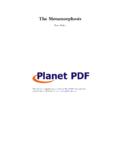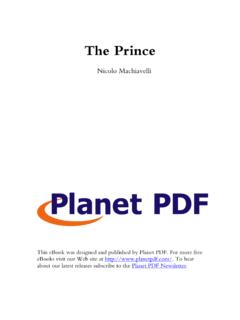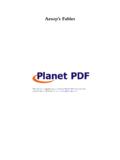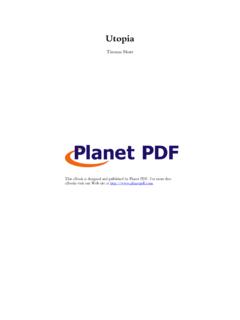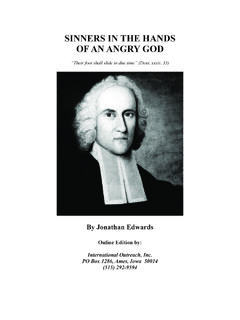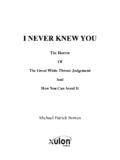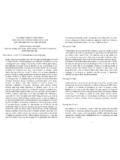Transcription of The Project Gutenberg eBook of The Literature of the ...
1 The Elysian Fields of the Egyptians according to the Papyrus of Ani. 1. Ani adoring the gods of Sekhet-Aaru. 3. Ani ploughing in the Other World. 2. Ani reaping in the Other World. 4. The abode of the perfect spirits, and the magical boats. THE. Literature . OF THE. ANCIENT EGYPTIANS. BY. WALLIS BUDGE, , Sometime Scholar of Christ's College, Cambridge, and Tyrwhitt Hebrew Scholar; Keeper of the Department of Egyptian and Assyrian Antiquities in the British Museum 1914. LONDON. DENT & SONS LIMITED. Aldine House, Bedford Street, [v]. PREFACE. This little book is intended to serve as an elementary introduction to the study of Egyptian Literature . Its object is to present a short series of specimens of Egyptian compositions, which represent all the great periods of literary activity in Egypt under the Pharaohs, to all who are interested in the study of the mental development of ancient nations. It is not addressed to the Egyptological specialist, to whom, as a matter of course, its contents are well known, and therefore its pages are not loaded with elaborate notes and copious references.
2 It represents, I believe, the first attempt made to place before the public a summary of the principal contents of Egyptian Literature in a handy and popular form. The specimens of native Egyptian Literature printed herein are taken from tombs, papyri, stel , and other monuments, and, with few exceptions, each specimen is complete in itself. Translations of most of the texts have appeared in learned works written by Egyptologists in English, French, German, and Italian, but some appear in English for the first time. In every case I have collated my own translations with the texts, and, thanks to the accurate editions of texts which have appeared in recent years, it has been found possible to make many hitherto difficult passages clear. The translations are as literal as the difference between the Egyptian and English idioms will permit, but it has been necessary to insert particles and often to invert the order of the words in the original works in order to produce a connected meaning in English.
3 The result of this has been in many cases to break up the [vi] short abrupt sentences in which the Egyptian author delighted, and which he used frequently with dramatic effect. Extraordinarily concise phrases have been paraphrased, but the meanings given to several unknown words often represent guess-work. In selecting the texts for translation in this book an attempt has been made to include compositions that are not only the best of their kind, but that also illustrate the most important branches of Egyptian Literature . Among these religious, mythological, and moral works bulk largely, and in many respects these represent the peculiar bias of the mind of the ancient Egyptian better than compositions of a purely historical character. No man was more alive to his own material interests, but no man has ever valued the things of this world less in comparison with the salvation of his soul and the preservation of his physical body.
4 The immediate result of this was a perpetual demand on his part for information concerning the Other World, and for guidance during his life in this world. The priests attempted to satisfy his craving for information by composing the Books of the Dead and the other funerary works with which we are acquainted, and the popularity of these works seems to show that they succeeded. From the earliest times the Egyptians regarded a life of moral excellence upon earth as a necessary introduction to the life which he hoped to live with the blessed in heaven. And even in pyramid times he conceived the idea of the existence of a God Who judged rightly, and Who set "right in the place of wrong." This fact accounts for the reverence in which he held the Precepts of Ptah-hetep, Kaqemna, Herutataf, Amenemh t I, Ani, Tuauf, Amen-hetep, and other sages. To him, as to all Africans, the Other World was a very real thing, and death and the Last Judgment were common subjects of his daily thoughts.
5 The great antiquity of this characteristic of the Egyptian is proved by a passage in a Book of Precepts, which was written by a king of the ninth or tenth dynasty for his son, who reigned under the name of Merikar . The royal writer in it reminds his son that the Chiefs [of Osiris] [vii]who judge sinners perform their duty with merciless justice on the Day of Judgment. It is useless to assume that length of years will be accepted by them as a plea of justification. With them the lifetime of a man is only regarded as a moment. After death these Chiefs must be faced, and the only things that they will consider will be his works. Life in the Other World is for ever, and only the reckless fool forgets this fact. The man who has led a life free from lies and deceit shall live after death like a god. The reader who wishes to continue his studies of Egyptian Literature will find abundant material in the list of works given on pp.
6 256-8. WALLIS BUDGE. British Museum, April 17, 1914. [ix]. CONTENTS. Thoth, the Author of Egyptian Literature . I. 1. Writing Materials, Papyrus, Ink and Ink-pot, Palette, &c. II. The Pyramid Texts: 9. The Book of Opening the Mouth 13. The Liturgy of Funerary Offerings 16. Hymns to the Sky-goddess and Sun-god 18. The King in Heaven 20. The Hunting and Slaughter of the Gods by the King 21. III. Stories of Magicians who Lived under the Ancient Empire: 25. Ubaaner and the Wax Crocodile 25. The Magician Tchatcham nkh and the Gold Ornament 27. Teta, who restored Life to Dead Animals, &c. 29. Rut-tetet and the Three Sons of R 33. IV. The Book of the Dead: 37. Summary of Chapters 42. Hymns, Litany, and Extracts from the Book of the Dead 44. The Great Judgment 51. V. Books of the Dead of the Gr co-Roman Period: 59. Book of Breathings 59. Book of Traversing Eternity 61. The Lamentations of Isis and Nephthys 62.
7 The Festival Songs of Isis and Nephthys 64. The Book of Making Splendid the Spirit of Osiris 64. VI. The Egyptian Story of the Creation 67. VII. Legends of the Gods: 71. The Destruction of Mankind 71. The Legend of R and Isis 74. The Legend of Horus of Behutet 77. The Legend of Khnemu and the Seven Years' Famine 83. The Legend of the Wanderings of Isis 87. The Legend of the Princess of Bekhten 92. VIII. Historical Literature : 98. Extract from the Palermo Stone 100. Edict against the Blacks 101. Inscription of Usertsen III at Semnah 101. Campaign of Thothmes II in the S d n 102. Capture of Megiddo by Thothmes III 103. The Conquests of Thothmes III summarised by Amen-R 106. Summary of the Reign of Rameses III 110. The Invasion and Conquest of Egypt by Pi nkhi 116. IX. Autobiographical Literature : 126. The Autobiography of Una 127. The Autobiography of Herkhuf 131. The Autobiography of Ameni Amenemh t 135.
8 The Autobiography of Thetha 137. The Autobiography of Amasis, the Naval Officer 140. The Autobiography of Amasis, surnamed Pen-Nekheb 143. The Autobiography of Tehuti, the Erp 145. The Autobiography of Thaiemhetep 149. X. Tales of Travel and Adventure: 155. The Story of Sanehat 155. The Story of the Educated Peasant Khuenanpu 169. The Journey of the Priest Unu-Amen into Syria 185. XI. Fairy Tales: 196. The Tale of the Two Brothers 196. The Story of the Shipwrecked Traveller 207. XII. Egyptian Hymns to the Gods: 214. Hymn to Amen-R 214. Hymn to Amen 219. Hymn to the Sun-god 220. Hymn to Osiris 221. Hymn to Shu 222. XIII. Moral and Philosophical Literature : 224. The Precepts of Ptah-hetep 225. The Maxims of Ani 228. The Talk of a Man who was tired of Life with His Soul 231. The Lament of Khakhepersenb, surnamed Ankhu 235. The Lament of Apuur 236. XIV. Egyptian Poetical Compositions: 241. The Poem in the Tomb of Antuf 242.
9 XV. Miscellaneous Literature : 244. The Book of Two Ways 244. The Book "Am Tuat" 244. The Book of Gates 246. The Ritual of Embalmment 247. The Ritual of the Divine Cult 248. The Book "May My Name Flourish" 250. The Book of apep 250. The Instructions of Tuauf 250. Medical Papyri 252. Magical Papyri 252. Legal Documents 253. Historical Romances 254. Mathematical Papyri 254. Editions of Egyptian Texts, Translations, &c. 256. Index 259. [xii]. ILLUSTRATIONS. The Elysian Fields of the Egyptians Frontispiece Thoth, the Scribe of the Gods 3. Thoth and Amen-R succouring Isis 5. Egyptian Writing Palettes To face 6. Vignette from the Book of the Dead (Chapter XCII) To face 42. Her-Heru and Queen Netchemet reciting a Hymn To face 44. Her-Heru and Queen Netchemet standing in the Hall of Osiris To face 52. Stele relating the Story of the Healing of Bentresht 94. Stele on which is cut the Speech of Amen-R 107.
10 A Page from the Great Harris Papyrus To face 110. Stele on which is cut the Autobiography of Thaiemhetep 150. A Page of the Tale of the Two Brothers To face 196. [1]. THE Literature OF. THE ANCIENT EGYPTIANS. CHAPTER I. THOTH, THE AUTHOR OF EGYPTIAN Literature . WRITING MATERIALS, ETC. The Literature of ancient Egypt is the product of a period of about four thousand years, and it was written in three kinds of writing, which are called hieroglyphic, hieratic, and demotic. In the first of these the characters were pictures of objects, in the second the forms of the characters were made as simple as possible so that they might be written quickly, and in the third many of them lost their picture form altogether and became mere symbols. Egyptian writing was believed to have been invented by the god Tehuti, or Thoth, and as this god was thought to be a form of the mind and intellect and wisdom of the God who created the heavens and the earth, the picture characters, or hieroglyphs as they are called, were held to be holy, or divine, or sacred.
